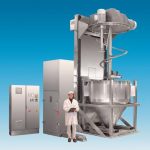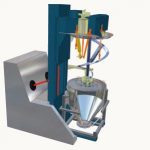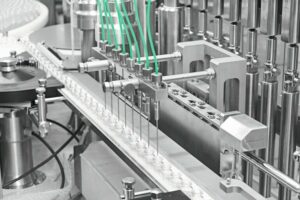The greater the number of components, the lower the level of automation that can be employed for mixing, and the more expensive each kilogramme of mixed materials becomes. The use of so-called container mixers can offer a way out of this component limitation. The Mixtainer is a more advanced version of this apparatus from Amixon for applications of this kind. The conical container functions simultaneously as the mixing chamber.
Stefan Ruberg
Mixtainers are rotationally symmetrical stainless-steel containers, in which the mixing tool rotates close to the wall. A sealing element at the bottom is integrated in such a way as to create zero clearance. The container is surrounded by impact protection and closed with a lid. The mixing operation of container mixers is fundamentally different from that of conventional mixing systems. The Mixtainer moves towards the individual components with which it is filled one by one. This is done by fitting it into an Azo Componenter and then moving it along underneath a row of component silos. The materials involved in the formulation are automatically dosed in the correct proportions. If new formulations require additional components to be stocked, it is simply necessary to extend the row and fit further silos with dosing stations. The high level of automation is retained. This means maximum production reliability, production data acquisition and batch traceability.
The Mixtainer finally reaches the mixing station, where it is manually or automatically secured in a holder. Its geometrical position in relation to the mixing station is accurately fixed. The cover is removed automatically and the helical blade mixing tool plunges from above into the Mixtainer. It makes its way into the materials rather like a corkscrew and the mixer header plate is then placed on the container flange.
Mixing technology in every corner
In the Mixtainer the materials at the edge of the container are screwed upwards before flowing down in the centre under the influence of gravity. Intensive cross-flows can be superimposed by tilting the entire system away from the vertical. Materials mixed to an ideal degree are usually achieved in this way within three to five minutes – regardless of the level of filling, the varying properties of the bulk material and the rotational speed of the mixing device. What’s more, the same container mixer can be used both for mixing processes in which the materials must be significantly broken up and for those containing grains which must be treated gently. The mixing gear is unscrewed from the materials when the mixing process is complete. If necessary, residual material is wiped off the mixing device and the cover is automatically replaced.
Cutting rotors are used if highly viscous liquids need to be mixed in or agglomerates or lumps require breaking up. They are also placed into the Mixtainer from above. Deagglomeration powers of up to 30 kW at about 3000 rotations per minute result.
Container mixer becomes a reactor
The Mixtainer can be replaced by a pres-sure-proof and vacuum-proof Reactainer. The Reactainer can be heated, either by means of a double jacket or with electric heaters. It is insulated and designed for vacuum operation, and it permits the fast transfer of heat to the materials. The Reactainer is closed underneath by a gas-tight, pressure-proof shut-off valve. Even though pumpable materials have meanwhile been mixed, steamed, boiled and processed in container mixers for some time, the reactor-mixer described here can be used for suspensions and loose bulk materials as well as for liquids and creams.
The utility value of a mixer-dryer depends heavily on the achievable evaporation power. The latter can be increased beyond that of the heated Mixtainer if the mixing device is also heated. This achieves the same drying results as paddle-through dryers, but in a significantly shorter time.
cpp 426
Mixtainers are rotationally symmetrical stainless-steel containers, in which the mixing tool rotates close to the wall. A sealing element at the bottom is integrated in such a way as to create zero-clearance. The container is surrounded by impact protection, and is closed with a lid. The mixing operation of container mixers is fundamentally different from that of conventional mixing systems. The Mixtainer moves towards the individual components with which it is filled one by one. This is done by fitting it into an Azo Componenter, and then moving it along underneath the row of component silos. The materials involved in the formulation are automatically dosed in the correct proportions. If new formulations require additional components to be stocked, it is only necessary to extend the row and to fit further silos with dosing stations. The high level of automation is retained. And this brings a maximum of production security, recording of operational data and batch traceability.
The Mixtainer finally reaches the mixing station, and is then a manually or automatically secured into a holder. Its geometrical position in relation to the mixing station is then accurately fixed. The cover is removed automatically, and the helical blade mixing tool plunges from above into the Mixtainer. It makes its way into the materials rather like a corkscrew, and the mixer header plate is then placed on the container flange.
Mixing technology in every corner
In the Mixtainer the materials that are the edge of the container are screwed upwards, flowing down in the centre under the influence of gravity. Intensive cross-flows can be superimposed by tilting the entire system away from the vertical. Materials mixed to an ideal degree are usually achieved in this way within three to five minutes – regardless of the level of filling, the varying properties of the bulk material and the rotation speed of the mixing device. The same container mixer, what is more, can be used both for mixing processes in which the materials must be significantly broken up as well as for those containing grains which must be treated gently. The mixing gear is unscrewed from the materials when the mixing process is complete. If necessary, residual material is wiped off the mixing device, and the cover is automatically replaced.
Cutting rotors are used if highly viscous liquids are to be mixed in, or if agglomerates/lumps require breaking up. They are also placed into the Mixtainer from above. Deagglomeration powers of up to 30 kW at about 3000 rotations per minute result.
The container mixer becomes a reactor
The Mixtainer can be replaced by a pressure-proof and vacuum-proof Reactainer. The Reactaner can be heated, either by means of a double jacket or with electrical heaters. It is insulated, and has been designed for vacuum operation, and it permits the fast transfer of heat to the materials. The Reactainer is closed underneath by a gas-tight, pressure-proof shut-off valve. Even though pumpable materials have now been mixed, steamed, boiled and processed in container mixers for some time, the reactor-mixer described here can be used for suspensions and loose bulk materials as well as for liquids and creams.
The utility value of a mixer-dryer depends heavily on the achievable evaporation power. The latter can be increased beyond that of the heated Mixtainer if the mixing device is also heated. This achieves the same drying results as paddle-through dryers, but in a significantly shorter time.
cpp 427
MischerExpo – Virtual exhibition for mixers, agitators and kneaders
Technopharm 2005
Share:








